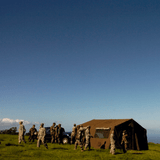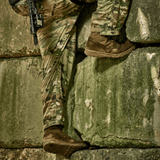Are Military Surplus Boots Comfortable? Tips for Breaking Them In
Military surplus boots are built to withstand rough terrain, bad weather, and long hours on foot—so they can be a great choice for hiking, hunting, or preparedness. But a common question people ask is: Are military boots actually comfortable to wear?
The quick answer: they can be, but you will likely need to break them in first.
What to Expect from Military Surplus Boots
Military boots are designed for function. They’re tough, durable, and made to support your feet under heavy loads, rocky ground and long marches. Comfort is relative to what you are used to in a civilian boot. Modern combat boots have been upgraded to be lighter and more comfortable but in a lot of cases they are built heavier for the reasons above.
On the plus side though, military boots will outlast most hiking boots many times over. I like to compare a boot such as a Danner USMC combat boot or Army Hot Weather Boot with a heavy duty welted mountaineering or backpacking boot. Military boots make exceptional work boots especially in rural environments, construction and farm work.
New vs. Used Military Boots
Used boots, while durable enough to last through several owners, will already be broken in. This means they may be shaped to fit the previous owner’s feet. If they are in good gently used condition they are a great buy and will last a long time. They may also have degraded insoles or misshapen heels—all of which can affect comfort and even lead to foot pain if for example a corner of the heel is worn down due to pronating from prior use.
Because of this, military boots are something you should buy new. It will take some time to break them in, but at least they will be broken in to fit your feet. If you really want to buy used military boots, then it is best to try them on in person or buy from an online store that has a good return policy in case they don’t fit.
Also read: New vs. Used Military Surplus Gear
Sizing Military Boots
When sizing military boots, it’s important to remember that your feet will swell slightly a bit when hiking long distances over rough terrain. To accommodate the swelling, you generally need to go up half a size. The boots shouldn’t feel loose though: you should feel like your feet can “breathe” in the boots and the boots aren’t tight anywhere.
When fitting boots we always suggest that “Boots should fit snug in the sides, fit in the heel with room to wiggle your toes” New boots will slip about ⅛ of an inch in the heel until they are broken in. With that in mind many military uniforms or combat boots run big. Ask before you buy how they fit. A lot of online stores will post fit recommendations so if you're not familiar with the brand or style take their advice.
How to Break In Military Combat Boots
1. Get Your Miles In
When it comes to breaking in boots, there’s no substitute for walking in them. Because military boots are so tough, don’t expect a few strolls to be enough. You’ll need to wear the boots on many treks, ideally on different terrain, to help soften the leather and mold them to your feet.
As you are breaking in the boots, pay attention to whether there are any hot spots or painful areas. Be prepared to bandage these areas, so have a first aid kit handy.
2. Wet Method
An old school soldiers often use the wet method for breaking in their boots:
- Put the boots in a tub of water overnight.
- Dry them with a towel in the morning.
- Wear the boots throughout the day.
- Change socks frequently (or blisters will occur).
- Repeat the process the next day if there are still tight spots.
Note that this method only works if you wear the boots while wet, and ideally walk around in them a lot. If you just get the boots wet and don’t wear them, the leather can dry in ways that don’t fit your feet and the boots will become less comfortable.
3. Two Socks or Liner Method
Blisters occur when there is friction against skin, such as from poor-fitting boots that aren’t molded to your feet. Having wet feet also increases the risk of blisters because skin softens when wet. One way to reduce friction and wetness—and thus reduce blister risk.
We do not love wearing two pairs of regular socks but some people still do. It was a thing when socks were not technical and was a way to help wick perspiration. Now that boot socks are made with more hydrophobic material woven in it is not needed. We do recommend liners however for the break in.
- Inner Sock: This sock should be very thin, such as a silk dress sock or even a woman’s nylon stocking. This still works really well.
- Outer Sock Material: Cotton socks are just not the answer ever. A good technical sock does not need to be thick unless you like it. Wool blends are always great!
The inner sock essentially acts as a base layer to wick moisture away from the feet and prevent the boot from directly rubbing on the skin. The second sock acts as insulation and further reduces friction. If you are going to use the wet method for breaking in boots, it’s highly recommended that you wear two socks.
4. Condition Leather Boots
If your military boots are full grain leather, use a leather conditioner to soften the material. This can speed up the break-in process and prevent cracking. The conditioner for baseball mitts is often a good choice because mitts, like military boots, are made from thick leather. We use any boot oil and there are a lot out there. Saddle Soap was the long timer standard.
5. Use Temporary Cushioning
If you're getting a lot of slipping and the size is correct adding some extra padding to take up space can be good. Another military trick is to put a couple maxi pads inside the boots while breaking them in. The pads provide some cushioning and comfort. After a few days, remove one of the pads. And, after another few days, switch one pad for a thinner one, until you can walk in the boots comfortably without any padding. They can be attached to the inside of the upper boot touching the top of your foot or under the insole. This helps most with heel slipping.
6. Adjust the Lacing Method
If you still feel hot spots or are getting blisters, try different lacing techniques. There are many methods which can reduce pressure in certain areas, or provide more stability so your foot isn’t sliding around.







